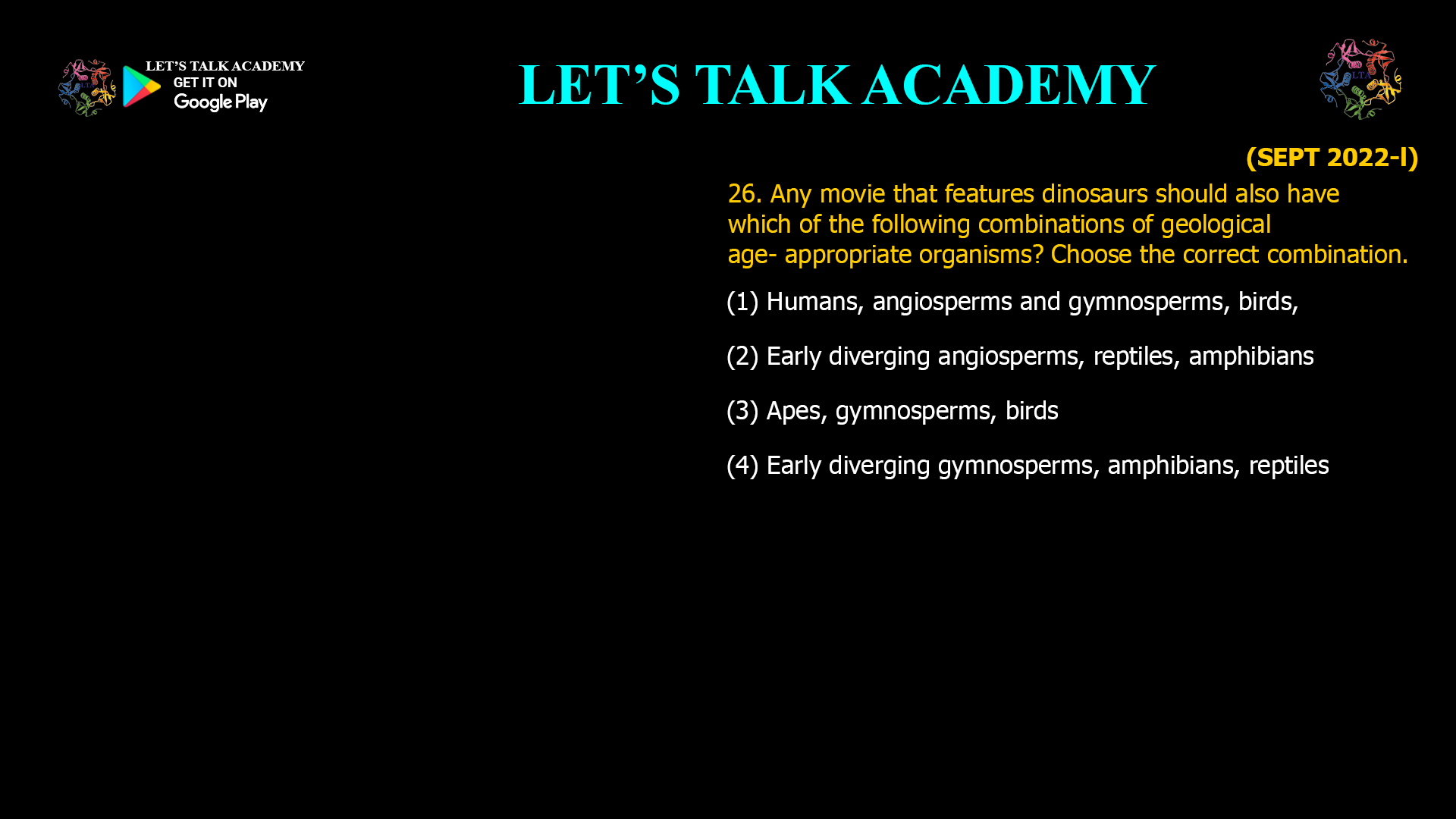- Any movie that features dinosaurs should also have which of the following combinations of geological age- appropriate organisms? Choose the correct combination.
(1) Humans, angiosperms and gymnosperms, birds,
(2) Early diverging angiosperms, reptiles, amphibians
(3) Apes, gymnosperms, birds
(4) Early diverging gymnosperms, amphibians, reptilesThe Essential Guide to Organisms That Coexisted with Dinosaurs: Authentic Mesozoic Companions for Accurate Dinosaur Movies
When you think of dinosaurs, what other creatures come to mind? For filmmakers, educators, and dinosaur enthusiasts, accurately portraying the world of the Mesozoic Era is crucial for both entertainment and scientific credibility. Yet, many movies and media make the mistake of pairing dinosaurs with creatures that never shared their world. This article will clarify which organisms truly coexisted with dinosaurs, ensuring your prehistoric scenes are as authentic as possible.
Understanding the Mesozoic Era: The Age of Dinosaurs
The Mesozoic Era, spanning from about 252 to 66 million years ago, is divided into three periods: Triassic, Jurassic, and Cretaceous. Dinosaurs dominated these periods, but they were far from alone. The flora and fauna of the Mesozoic were unique, and understanding them is key to creating a believable prehistoric environment.
The Dominant Flora: Gymnosperms and Early Plants
During most of the Mesozoic, gymnosperms were the dominant plants. These included conifers, cycads, ginkgoes, and seed ferns. Unlike today’s lush, flowering landscapes, Mesozoic forests were primarily green with needle-like leaves and cones. Angiosperms, or flowering plants, only appeared towards the end of the Cretaceous period and were not widespread until after the dinosaurs’ extinction.
The Animal Kingdom: Amphibians and Reptiles
Dinosaurs shared their world with a variety of amphibians and reptiles. Ancient frogs, salamanders, and their relatives thrived in wet environments. Reptiles, including early crocodiles, turtles, lizards, and tuataras, were widespread and diverse. Some of these lineages, like crocodiles and turtles, have survived to the present day, offering a living link to the age of dinosaurs.
Common Misconceptions: What Did Not Coexist with Dinosaurs
One of the most persistent errors in popular culture is the depiction of humans or modern mammals living alongside dinosaurs. In reality, humans and apes evolved tens of millions of years after the last non-avian dinosaurs disappeared. Similarly, many modern plants and animals, such as flowering trees, grasses, and advanced mammals, did not appear until long after the Mesozoic.
Why Not Angiosperms or Birds?
While angiosperms (flowering plants) did emerge in the late Cretaceous, they were not the dominant flora during most of the dinosaur era. Likewise, birds are indeed descendants of certain theropod dinosaurs and appeared in the Jurassic, but pairing them with anachronistic animals like humans or apes in media is scientifically inaccurate.
The Correct Combination: Gymnosperms, Amphibians, and Reptiles
If you want to create a scientifically accurate depiction of a dinosaur’s world, the most appropriate combination of coexisting organisms is:
-
Early diverging gymnosperms (such as conifers, cycads, ginkgoes)
-
Amphibians (frogs, salamanders, and their ancient relatives)
-
Reptiles (early crocodiles, turtles, lizards, tuataras)
This trio best represents the flora and fauna that would have surrounded dinosaurs during the Mesozoic Era. Let’s explore each group in more detail.
Gymnosperms: The Forests of the Dinosaurs
Gymnosperms were the backbone of Mesozoic plant life. These plants reproduce with seeds that are not enclosed in flowers or fruits, unlike angiosperms. The forests were dense with towering conifers, cycads with their palm-like leaves, and the distinctive fan-shaped leaves of ginkgoes. These plants provided food and shelter for many dinosaurs, especially the large herbivores.
Amphibians: Survivors from an Ancient Past
Amphibians have a lineage stretching back over 350 million years. During the Mesozoic, ancient frogs and salamanders thrived in lakes, rivers, and swamps. Their presence added diversity to the ecosystems, serving as both predators and prey. Their permeable skin and aquatic larvae made them sensitive indicators of environmental changes, just as they are today.
Reptiles: The Diverse Companions
Reptiles were everywhere during the Mesozoic. Crocodilians, which first appeared in the Triassic, shared rivers and lakes with dinosaurs and have changed little since. Turtles, with their protective shells, also date back to this era. Lizards and tuataras, though often overshadowed by their dinosaurian relatives, were important parts of the ecosystem, filling niches from insectivores to small predators.
Why Accuracy Matters in Dinosaur Depictions
Accurate portrayal of prehistoric life is not just a matter of scientific pride; it shapes public understanding of Earth’s history. When movies or educational materials show humans or modern animals alongside dinosaurs, they create lasting misconceptions. By choosing the right companions—gymnosperms, amphibians, and reptiles—you help audiences appreciate the true wonder and diversity of ancient life.
Tips for Creating Authentic Dinosaur Worlds
-
Research the specific period: The Triassic, Jurassic, and Cretaceous each had unique ecosystems. Tailor your flora and fauna accordingly.
-
Avoid anachronisms: No humans, apes, or modern mammals. Stick to plants and animals with fossil evidence from the Mesozoic.
-
Include early birds and angiosperms only in late Cretaceous settings: If your story is set in the last 30 million years of the dinosaur era, you can add primitive flowering plants and early birds, but keep their diversity limited.
-
Showcase diversity: The Mesozoic was not just about dinosaurs. Highlight the variety of amphibians and reptiles that shared their world.
Conclusion: Bringing Prehistoric Worlds to Life
The age of dinosaurs was a time of incredible biodiversity, but it was fundamentally different from today’s world. By focusing on early diverging gymnosperms, amphibians, and reptiles, you can create authentic, awe-inspiring depictions of prehistoric life. Whether you’re making a film, writing a book, or teaching a class, accuracy honors the true history of our planet and inspires a deeper appreciation for the life that once flourished here.
-



